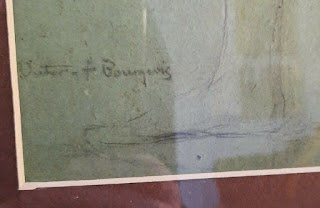I was browsing eBay France this week when I happened upon an amazing academic study of a nude boy by the well listed French Artist Victor Ferdinand Bourgeois (1870 - 1957). The drawing didn’t, at first glance, look as much, but then again I took a second closer look....... As I carefully traced with my eye along the pencil lines constructing that human figure, I was simply amazed at the painterly quality of that bare essential composition and most of all the absolute mastery of depicting human anatomy the artist had obtained. Let your eye trace the figure from neck, along the shoulder, down the back to the hips then down the left leg. Then let your eye trace the line from the folded hands down and around the abdomen to the attachment of the male genitalia and it’s attachment to the body. Now follow that line down the front edge of the left leg. Now pull back and notice how the very barest of shading reinforces the volume of what that beautiful line has defined............I have come to the realization personally that I can obtain that sort of accurate depiction of the human form in such brevity only with my eye and never with my hand...........Alas, such is the way of things. Perhaps I can obtain that detail in the next life. There is more to this drawing than first meets the eye. Just follow the lines. Unlike the von Hoffmann nude study which cost an arm and a leg, I had to sacrifice just a few toes for this one.
The following biographical information was retrieved from the Avery & Dash website regarding the artist:
“Victor-Ferdinand Bourgeois studied at the R̩gionale des Beaux-Arts in Somme and at the Arts D̩coratifs in Paris where he won major prizes. Assessed as hors-concours in 1892, which guaranteed him a place to compete in future Salons he was appointed the same year to the art directorship of the world renowned royal Manufacture Nationale de Porcelaine de S̬vres. Bourgeois then joined the studio of the famous master Luc-Olivier Merson, who had just been elected to the Acad̩mie des Beaux-Arts.
In the 1894 Beaux-Arts competition Bourgeois came first of four hundred students and in 1897 won the Prix Chenavard, enabling him to participate in the Artistes Fran̤ais the following year. There he exhibited a vast allegorical composition which was immediately acquired by the French government. Exhibited at the 1900 World Fair, the canvas was awarded a bronze medal. Further successes followed. Active in the Parisian art world in the early years of the 20th century, Bourgeois was a founding member of the avant-garde Salon Automne, launched in 1903. Victor-Ferdinand Bourgeois’ early color palette was dark as his subject matters were formal and his style very Academic. Then the artist associated with Impressionism; the year 1907 marked a radical change in his work when Bourgeois, invited by the famous impressionist painter Armand Guillaumin to join him in Southern France, discovered its intense light and his palette definitely brightened. Together they explored the French Riviera which offered the two artists an exceptional panoramic subject and a chromatic impact that was utterly overwhelming for Bourgeois, as it had been for Guillaumin during his first visit in 1885.
Bourgeois produced many luminous works directly from nature, later transformed into incandescent paintings and pastels. With their Fauvist touches, these works constituted a point of no return. Bourgeois had finally discovered the way forward. From that moment on, he painted Nature with the same eyes as Guillaumin, and, thanks to his colleagues, tapped into the sensibility of Monet, Sisley, Gauguin and Othon Friesz, who all loved and celebrated the Southern light. That Bourgeois had assimilated Impressionist models can be seen in the light, vibrant brushstrokes of "Nice. Le d̩part du bateau grec" painted during a winter trip to the South of France in 1907 as well as in this work depicting the famous promenade des anglais a magnet to the English aristocracy during the winter season. During this period of intense activity, Bourgeois's paintings began to appear abroad, notably in Brazil and the United States, where several were prominently featured in the International Picture Exhibitions of Buenos Aires and Pittsburg (Carnegie Institute).Enjoy.




















































